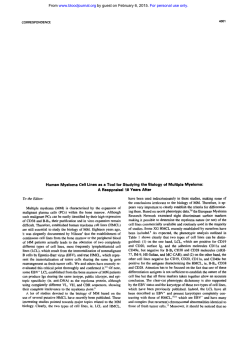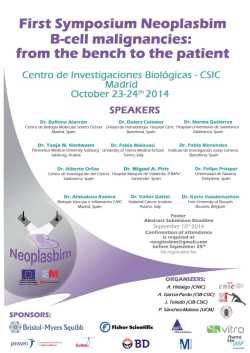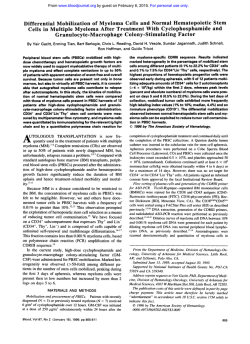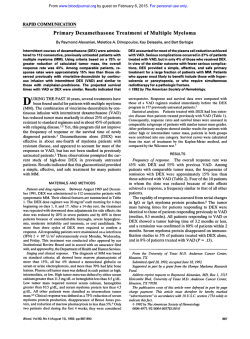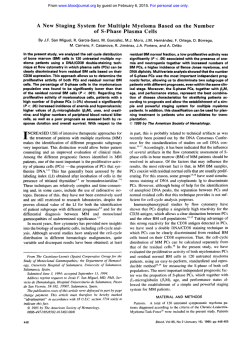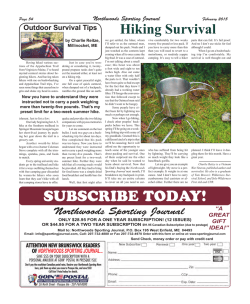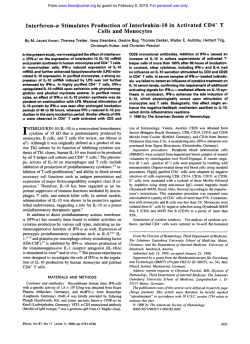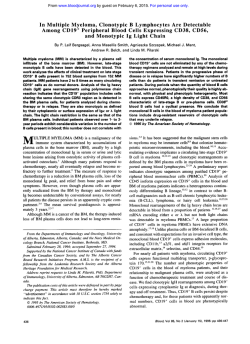
Natural Interferon-a in Combination With Melphalan
From www.bloodjournal.org by guest on February 6, 2015. For personal use only. Natural Interferon-a in Combination With Melphalan/Prednisone Versus Melphalan/Prednisone in the Treatment of Multiple Myeloma Stages I1 and 111: A Randomized Study From the Myeloma Group of Central Sweden By Anders Osterborg, Magnus Bjbrkholm, Mats Bjoreman, Gunilla Brenning, Kristina Carlson, Fredrik Celsing, Gosta Gahrton, Gunnar Grimfors, Hans Gyllenhammar, Robert Hast, Bo Johansson, Gunnar Juliusson, MBrten Jarnmark, Eva Kimby, Richard Lerner, Olle Linder, Karl Merk, Bo Nilsson, Mikael Ohrling, Christer Paul, Bengt Simonsson, Bengt Smedmyr, Erik Svedmyr, Ann-Marie Stalfelt, Hans Strander, Ann-Marie UdBn, Eva Osby, and HBkan Mellstedt Three hundred thirty-five previously untreated patientswith multiple myeloma in clinical stages II and 111 entered a randomized trial comparing intermittent oral melphalan and prednisone(MP)therapy (n = 171)with MP in combination with natural (leukocyte-derived) a-interferon (MP/IFN) (n = 164).The treatment groups were comparable with regard to major prognostic factors. The response frequency was 42% in the MP group and 68% in the MP/IFN group (P < .OOOl).Eighty-fivepercent of IgA myelomas and 71 % of Bence-Jones myelomas respondedto MP/IFN compared with 48% and 27%. respectively, to MP treatment (P = .OOl).There was no difference in the overall survival between the two treatment groups. However, the survival of 72 patients with IgA or Bence-Jones myeloma randomized to receive MP/IFN was significantly longer (median 32 months) than that of 71 patients treated with MP (median 17 months) (p < .05). No statistically significant difference in response frequency (60% v 46%) or survival was found for patients with IgG myeloma. Hematologic toxicity, WHO grades 111 and IV, was higher in the MP/IFN group (48%) than in the MP group (33%)(P < .05) during the induction treatment period. Flulike syndrome was observed in 68% of patients receiving MP/IFN. The results show that MP/ IFN is a well-tolerated treatment regimen, superior to M P for remission induction, and it improves significantly the overall survival for patients with IgA and Bence-Jonesmyelomas. 0 1993 by The American Society of Hematology. I Interferon-a (IFN-a) is a biologic agent that inhibits myeloma plasma cell growth in vitro in a dose-dependent manner.’ IFN-a alone (3 X lo6 IU/d) induced a response rate of about 15% in previously untreated patients with multiple myeloma.10.”Higher doses seemed to improve the response frequency.” In a semisolid agar system, a synergistic effect between IFN-a and melphalan on growth inhibition of myeloma cells was noted. Prednisone had an additive effect. The inhibitory effect was dose dependent.13 Based on these results, a randomized trial was started in April 1986 with the aim to analyze whether the addition of IFN-a to standard MP treatment could improve the therapeutic outcome of newly diagnosed patients with multiple myeloma stages I1 and 111. This report is the final analysis. NTERMITTENT melphalan and prednisone (MP) treatment’ is still regarded by many clinicians as one of the primary standard therapies for patients with multiple myeloma. MP induces a response rate of 40% to 50% in previously untreated patients, with a median survival of approximately 3 years. The clinical value of intensive combination chemotherapy (CCT) has been analyzed in several studies, some of which have shown an increased response rate as well as prolonged survival on CCT,2,3whereas others have demonstrated no beneficial therapeutic effect of CCT.4-7A recent meta-analysis comprising more than 3,800 patients demonstrated that CCT does not consistently improve the prognosis, but with the possible exception of patients with poor prognostic signs. MP might be superior in patients who have a good prognosis.’ Thus, there is a real need for other treatment approaches that may improve the outcome for patients with multiple myeloma. From the Departments of Oncology (Radiumhemmet), Biostatistics, and Medicine, Karolinska Hospital, Stockholm; the Department of Medicine, Danderyd Hospital, Stockholm; the Department of Medicine, Huddinge Hospital, Stockholm; the Department of Medicine, South Hospital, Stockholm; the Department of Medicine, Academic Hospital, Uppsala;and the Department of Medicine, Orebro Hospital, Orebro, Sweden. Submitted September 10, 1992; accepted November 10, 1992. Supported by grants from the Cancer Society in Stockholm, the Swedish Cancer Society, the Elina Andersen Foundation, and the Karolinska Institute Foundations. This study was approved by the Ethics Committee of the Karolinska Institute. Address reprint requests to HGkan Mellstedt, MD, PhD, Deputy Director, Department of Oncology (Radiumhemmet). Karolinska Hospital, 9 1 0 4 01 Stockholm, Sweden. The publication costs of this article were defayed in part by page charge payment. This article must therefore be hereby marked “advertisement” in accordance with 18 U.S.C.section 1734 solely to indicate this fact. 0 1993 by The American Society of Hematology. OV06-4971/93/8106-0008$3.00/0 1428 MATERIALS AND METHODS Patients Six hospitals participated in the study. Three-hundred thirty-five untreated patients with multiple myeloma stages I1 and were entered between April I , 1986 and September 15, 1991. Patients were excluded from entry if they had stage I disease or if they had received previous chemotherapy or radiotherapy. Informed consent was obtained from each patient. Pretreatment characteristics of the patients are shown in Table 1. The two treatment groups were comparable with regard to major prognostic factors. Follow-up was performed in February 1992. One hundred and sixty patients were evaluable for response in the MP group (94%)and 157 (96%) in the MP/ IFN group. All patients were evaluable for survival. Diagnostic Criteria The diagnosis of multiple myeloma was established when at least two of the following criteria were met: (1) a paraprotein detectable in serum or urine together with a subnormal concentration of at least one nonmonoclonal Ig class (IgG, IgM, and IgA); (2) greater than 10% plasma cells in bone marrow; and (3) osteolytic and/or osteoporotic bone lesions compatible with multiple myeloma.’’ Pretreatment evaluation included agarose electrophoresisof plasma and of 100 times concentrated urine; quantitation of plasma Igs using a nephelometer analyzer (Behring, Marburg, Germany) according to Blood, Vol8 1, No 6 (March 15). 1993: pp 1428-1434 From www.bloodjournal.org by guest on February 6, 2015. For personal use only. IFN-a AND MELPHALAN/PREDNISONE IN MYELOMA 1429 Table 1. Pretreatment Characteristics of the Patients Treatment Group Age (vr) Median Range Clinical stage II 111 M-component type IgG I9A Bence-Jones only Non-secretory IgD s-creatinine < 170 Mmol/L 2 170 Mmol/L MP (n = 171) MP/IFN (n = 164) 68 (43-87) 69 (40-87) 73 98 69 95 93 40 31 6 1 87 40 32 5 135 36 127 37 the manufacturer’s recommendation; quantitation of 24-hour urinary protein excretion with the Biuret technique16or, alternatively, quantitation of free light Ig chains using the single radial immunodiffusion according to Mancini’’ after pretreatment of the urine sample with polyethylenglycole 6000 (200 g/L); roentgenographic examination of the skull, vertebral column, and pelvic bones; and examination of bone marrow (BM) specimens obtained by aspiration and/or by trephine biopsy. The percentage of plasma cells was determined by counting at least 200 cells in separate view fields of stained smears. The initial evaluation further included erythrocyte sedimentation rate per 1 hour (ESR); hemoglobin concentration; white blood cell (WBC) count with differential; platelet and reticulocyte counts; salbumin; s-calcium; s-creatinine; s-uric acid and sliver enzymes. The clinical staging system according to Dune and Salmon14was used. least 25% of pretreatment or response value, respectively; (2) a 100% increase in 24-hour urinary Bence-Jones protein excretion of pretreatment or response value, respectively; (3) serum calcium 2 3 mmol/L; and (4) progression of osteolytic lesions. Treatment Design Patients were stratified for M-component subtype, clinical stage, and age (565 years) and randomly allocated to receive one of the two following treatment regimens. MP. Melphalan, 0.25 mg/kg/d, was administered orally on days 1 through 4. Prednisone, 2 mg/kg/d, was administered orally on days 1 through 4. The cycle length was 42 MP/IFN. Melphalan, 0.25 mg/kg/d, was administered orally on days 1 through 4. Prednisone, 2 mg/kg/d, was administered orally on days I through 4. Natural (leukocyte-derived) IFN-a (Finnferonalpha; Finnish Red Cross, Helsinki, Finland), 7 X IO6 IU/m2/d, was administered subcutaneously on days 1 through 5 and days 22 through 26. The cycle length was 42 days. When the patients fulfilled the response criteria, the IFN dose was reduced to 3 X 106 IU/d, subcutaneously, 3 days a week continuously and MP was continued at 6-week intervals. Treatment was continued until progression or relapse. Therapy at progression/relapse. When the criteria for progression/ relapse were fulfilled, all patients received EACB (etoposide, 50 mg/ m2 IV on day 1 and 100 mg/m2 orally on days 2 through 4; doxorubicin, 25 mg/m2 IV on day 1; cyclophosphamide, 500 mg/m2 IV on day 1; betamethasone, 30 mg/d orally on days I through 4). The cycle length was 28 days. Statistical Analyses Survival time was measured from the start of treatment to death or follow-up. Time to response was defined as the time from start of therapy until the date of registered response. Response duration was defined as the time from fulfillingthe criteria for response until relapse, death, or follow-up. Life table analysis was applied to data. Differences in total survival and in response duration time between groups were analyzed using the log rank test taking censored data into account.19 Differences in distribution were tested using the x2 analysis. Follow-Up Every third to sixth week, the following laboratory tests were performed ESR hemoglobin concentration; WBC count with differential; platelet and reticulocyte counts; s-albumin, s-calcium, and screatinine; electrophoresis of plasma and urine; plasma concentration of Igs; and 24-hour urinary protein excretion. Differential counts of BM smears were performed every third month. Skeletal radiograms were repeated when clinically indicated. RESULTS Response rate. Forty-two percent of the patients achieved a response in the MP group and 68% in the MP/IFN group (P< .OOO1) (Table 2). Median time to response was 5 months in both treatment groups. The response rate in clinical stage I1 patients was significantly higher in the MP/IFN group than Criteria For Response Clinical response. This was defined mainly according to the criteria proposed by the Committee of the Chronic Leukemia-Myeloma Task Force.I8 These criteria were (1) a decrease of the serum Mcomponent concentration to less than 50% of the pretreatment value; (2) a decrease of urinary excretion of light chain protein to less than 0.2 g/24 h. In addition, patients were classified as responders only if the hemoglobin level was e90 g/L, salbumin 230 g/L, and s-calcium 52.60 mmol/L. Complete remission. This was defined as total disappearance of the serum M-component and/or the urinary excretion of light chain protein and <5% plasma cells in the BM, hemoglobin, s-albumin, and s-calcium concentrations as for clinical response. Criteria for progression and relapse. Progression or relapse was attained when one or more of the following criteria were fulfilled: (1) an increase in the serum M-component concentration with at Table 2. Response Frequency (%) in Relation to Treatment Schedule MP Group Total Clinical Stage II 111 M-component type IgG IgA Bence-Jones only (n = 160)’ MP/IFN Group (n = 157)’ P Value 42 68 1.0001 38 (26/69) 46 (42/9 1) 76 (50/66) 62 (56/9 1) <.0001 .05 46 (40/87) 48 (19/40) 27 (8/30) 60 (5 1/85) 85 (33/39) 71 (22/31) NS .001 ,001 Abbreviation: NS, not significant. Number of evaluable patients at analysis. From www.bloodjournal.org by guest on February 6, 2015. For personal use only. 1430 1 \. dSTERBORG ET AL 1 ... 0.75 '. 0.75 E Ti 3 €d m 8 0.50 Ba 0.50 a n 0.25 ...... 0.25 0 1 2 1 3 4 5 6 SURVIVAL (YEARS) 0 0 1 2 3 4 5 SURVIVAL (YEARS) Fig 1. Total survival of patients treated with MP (n = 171) [-) and MP/IFN (n = 164) (-----) (not significant). Numbers within brackets indicate patients at risk. in the MP group (P< .0001) and in stage Ill the difference was almost statistically significant (P= .05). In patients with IgA or Bence-Jones myelomas, a significantlyhigher response frequency was noted in the MP/IFN group compared with the MP group (P= .001), whereas no significant difference was found for patients with IgG myelomas, although the numerical value was higher (60%v 46%). Complete remission rate. Seven percent of the patients in the MP group achieved complete remission, whereas 12% in the MP/IFN group achieved complete remission. Total survival. The total survival of MP/IFN-treated patients was not significantly longer than survival of patients who received MP therapy (Fig 1). The median survival was 29 months in the MP/IFN group and 27 months in the MP group. There was no significant difference in survival between the two treatment regimens when stage I1 and stage I11 patients were analyzed separately (Figs 2 and 3). Total survival of patients with IgA and Bence-Jones myelomas is shown in Fig 4. A significantly longer survival was found for patients treated with MP/IFN compared with patients given MP therapy (P< .05). No significant difference in survival of IgG myelomas was noted between the two treatment regimens (Fig 5 ) . Survival from response. Survival from response of patients treated with MP/IFN was not significantly longer than the corresponding survival of patients who received MP either in the total patient material or among patients with IgA and Bence-Jones myelomas. In addition, there was no statistically significant difference in response duration time measured from onset of clinical response. Fig 2. Total survival of stage II patients treated with MP (n = 73) (-) and MP/IFN (n = 69) (-----) (not significant [P = .21]). Numbers within brackets indicate patients at risk. Hematologic toxicity. The hematologic toxicity during the induction phase is shown in Table 3. WHO grade Ill or IV hematologic toxicity was observed in 33% of patients on MP therapy and in 48%of patients treated with MP/IFN (P < .05). During the response phase, 1 1% of MP/IFN-treated patients had grade IV toxicity. Thirty-three percent exhibited grade 111 toxicity, 35% grade 11, and 15%grade I hematologic toxicity. The corresponding values for MP-treated responding 1 0.75 > 5 I 0.50 m 0.25 1-1) 0 0 I 2 3 4 5 6 SURVIVAL (YEARS) Fig 3. Total survival of stage 111 patients treated with M P (n = 98) (-) and MP/IFN (n = 95) (-----) (not significant [f = .391). Numbers within brackets indicate patients at risk. From www.bloodjournal.org by guest on February 6, 2015. For personal use only. IFN-a AND MELPHALAN/PREDNISONE IN MYELOMA 1431 1 Table 3. Hematologic Toxicity According to WHO Grading During the Induction Phase 0.75 0.50 0.25 0 0 2 1 3 5 4 SURVIVAL (YEARS) Fig 4. Total survival of patients with IgA and Bence-Jones myelomas treated with MP (n = 71) (-) and MP/IFN (n = 72) ( - - - - - ) (P < .05). Numbers within brackets indicate patients at risk. patients were 8%of the patients exhibited grade IV toxicity, 30%grade III,22% grade 11, and 19%grade I. The differences were not statistically significant. A similar difference in hematologic toxicity was found within the various Ig isotype subgroups as in the total material comparing the two treatment groups (data not shown). 1 an I 0 I II 111 IV MP MP/IFN 16 10 19 15 32 26 23 34 10 14 WHO grade hematologictoxicity: for leukocytes (x109/L): grade I, 3.0 to 3.9; grade 11, 2.0 to 2.9; grade 111, 1.Oto 1.9: and grade IV, less than 1.O;for platelets (X 109/L): grade I, 75 to 99; grade 11, 5 0 to 74; grade 111, 25 to 49; and grade IV, less than 25. c 3B Frequency (%) of WHO Grade Toxicity Treatment Group asp Nonhematologic toxicity. Side effects of MP/IFN were usually moderate and tolerable. IFN-a induced transient flulike symptoms in 68% of MP/IFN-treated patients during the induction treatment period. Gastrointestinal symptoms or reversible central nervous system (CNS) symptoms (hemiparesis, mental confusion, depression) occurred in 3% of the patients, respectively. Two patients developed allergic reactions to IFN-a. One of the patients died from nonreversible allergic shock. One patient had a myocardial infarction during the first induction cycle and another developed a severe but reversible congestive heart failure. Both patients had a history of previous but stable cardiac disease. During the remission phase, a flulike syndrome was observed in 18% of the patients receiving IFN maintenance therapy. Gastrointestinal symptoms occurred in two patients and CNS symptoms (reversible depression) in one patient during the response phase. Dose reduction of melphalan. Seventy-three percent of the MP/IFN-treated patients and 64%of the MP-treated patients had no reduction of the melphalan dose during the induction treatment period. A reduction of 25% to 75% of the planned melphalan dose was done in 23% of MP/IFNtreated patients and in 34%of patients treated with MP only. Melphalan was withdrawn during the induction phase in six (4%)MP/IFN-treated patients and in three (2%) MP treated patients (Table 4). A similar difference in reduction of the melphalan dose was noted within the Ig isotype subgroups as in the total patient population comparing the two treatment groups (data not shown). Dose reduction of ZFN-a. Fifty-six percent of MP/IFNtreated patients had no reduction of the IFN dose during the induction treatment period. A reduction of 25% to 75% of :.....(h)) 0.28 Table 4. Frequency (%) of Dose Reduction of Melphalan and IFN-a During the Induction Treatment Period Dose Reduction 0 I 1 d i ; I i SURVIVAL 0 Fig 5. Total survival of patients with IgG myeloma treated with and MP/IFN (n = 87) (-----) (not significant [P MP (n = 93) (-) = .41]). Numberswithin brackets indicate patients at risk. (%I 0 25 50 75 100 MP/IFN Group (n = 164) MP Group (n = 171) Melphalan IFN-a Melphalan 73 16 5 2 4 56 15 9 3 17 64 18 12 4 2 From www.bloodjournal.org by guest on February 6, 2015. For personal use only. OSTERBORG ET AL 1432 Table 5. Reasons for Withdrawal of IFN-a During the InductionTreatment (n = 164) Cause No. of Patients Flulike syndrome Practical problems’ Leukocytopenia and/or thrombocytopenia CNS symptoms Renal dysfunction Myocardial infarction Congestive heart failure Allergic reaction Excessive diarrhea 7 5 4 3 2 *Practical problems included inability of self-administration of IFN-a, long distance to the hospital/doctor, no available district nurses. the planned IFN-a dose was done in 27% of the patients. In 25 patients (1 7%), IFN-awas withdrawn during the induction phase (Tables 4 and 5). Reduction of the IFN-a dose was similar in the different Ig isotype subgroups as in the total material. In 25 of the responding patients, the continuous low-dose IFN-awas withdrawn during the remission phase. Nine patients had a nontolerable flulike syndrome, 6 developed leukocytopenia and/or thrombocytopenia, 5 had practical problems, 2 had nausea, I had depression, and myelodysplastic syndrome developed in 2 patients. Time to withdrawal during the remission phase varied between I and 25 months (median 8 months). DISCUSSION The prognosis of patients with multiple myeloma treated with chemotherapy has not changed markedly during the last 25 years. In younger patients, promising results have recently been presented using intensive chemotherapy regimens followed by autologous20,21 or allogeneic2’ BM transplantation. However, as the median age of patients with multiple myeloma is about 67 years, the vast majority of patients are not candidates for such intensive treatment protocols. Therefore, other treatment regimens should be devised with the aim to improve the prognosis for patients with myeloma but with an acceptable toxicity. MP/IFN may represent such an alternative. The results of the present study show that the addition of IFN-a to MP increased the overall response rate in previously untreated patients with myeloma approximately 50% compared to MP alone. The most striking difference in response rate between MP/IFN and MP therapy was observed for patients with IgA and Bence-Jones myelomas. Eighty-five percent of the patients with IgA myeloma and 7 1% of those with Bence-Jones myeloma responded to MP/IFN, whereas the corresponding frequencies for MP therapy were only 46% and 27%, respectively. There was no statistically significant difference in the IgA and Bence Jones myeloma subgroup between the two treatment arms with regard to age, clinical stage, and renal dysfunction. IgA myeloma has also been shown in other studies to respond favorably to IFN-a thera ~ y . ” , ’ Moreover, ~ in three consecutive clinical trials, the Myeloma Group of Central Sweden (MGCS) has shown a high response rate for IgA and Bence Jones myelomas1°,12 (present study). The reason for the favorable response of these myeloma subtypes is not clear. The beneficial effect might be related to the use of leukocyte-derived IFN-a. In the majority of other trials, recombinant IFN-a has been administered and mostly no difference between the various Ig isotypes was seen. It should also be noted that our patients with myeloma did not develop antibodies to leukocyte-derived IFNwhich has been noted for IFN-a2, and I F N - ( u ~ ~ . ~ ~ , ~ ~ Moreover, a very high response rate was noticed for patients with myeloma stage 11, which has also been reported by Ludwig et The high response rate in the MP/IFN group was not associated with an improved survival in the total patient population. However, in patients with IgA and Bence Jones myelomas, a statistically significant prolongation of total survival was obtained. For IgG myelomas, no difference in survival between the two treatment groups was noted. Moreover, no statisticallysignificantdifferencein the response duration time and survival from response was found between the control group and study group. These findings may suggest that IFNa might be more effective during the induction treatment than in the response phase. Similar results have been published by Ludwig et ai2’ showing that VMCP chemotherapy plus IFN-ainduced a significantprolongation of total survival but not of response duration and survival from response compared with VMCP alone. These results are further corroborated by an MRC trial3 showing that intensive chemotherapy compared to melphalan alone prolonged total survival but not survival from response or the response duration time. A very high response rate as well as prolongation of survival for a regimen using MP/IFN also was reported in a small series by Montuoro et a1.’* However, in a large patient population by Cooper et a12’ and another by Corrado et al,30no increase in the response rate and no influence on survival was observed for an MP/IFN combination therapy protocol. Kyle et a1 demonstrated in a nonrandomized study that 80% of previously untreated myeloma patients responded to VBMCP plus IFN-a as compared to an expected response rate of 72% for VBMCP alone.31Twenty-six percent of the patients achieved a complete remission in this study. The complete remission rate for chemotherapy regimens in multiple myeloma varies from 5% to 10%for MP to 15%to 20% using CCT protocols. In intensive treatment protocols with BM rescue, the corresponding frequency is 27% to 43%.20,21 No beneficial effect of MP/IFN during the remission phase was noted in the present study, which differs from the results obtained by Mandelli et a132and Westin et al,” who found that a low dose of IFN-a only as maintenance therapy prolonged the remission duration time; and the Italian study also found prolonged survival from response. It should be noted, however, that in the Westin study the remission duration in the control group was only 6 months as compared with I8 months for the IFN-maintained group. Usually, the expected remission duration time for unmaintained patients In contrast to the results of is approximately 18 Mandelli et al and Westin et al, the German Myeloma Group found no benefit of IFN-a maintenance therapy either on From www.bloodjournal.org by guest on February 6, 2015. For personal use only. IFN-a AND MELPHALAN/PREDNISONE IN MYELOMA response duration or on survival from re~ponse.~’ The IFNa dose in our study was similar to that of the other studies during the maintenance phase, although our patients in addition received MP treatment every sixth week. Thus, the therapeutic value of IFN-a in the remission phase is still controversial. The present study does not support a role for IFNa during the maintenance phase. The reasons for the varying therapeutic results obtained in the different trials combining IFN-a and chemotherapy are not obvious. Some potential causes deserve to be pointed out. In various experimental systems and in humans, a doseresponse relationship for IFN-a has been n ~ t e d . ~Also, ~ ” ~a dose-response relationship may exist in multiple myeloma in vitro as well as in V ~ V O . ~ , ’ ~An , ’ ~ adequate ,~ dose of IFNa might thus be important. Comparing our study with that of Cooper et al,29 their patients received only 13 X lo6 IU/ m2 of IFN-a monthly, whereas in our study the patients received 50 X lo6 IU/m2 monthly during the induction period. The chemotherapy constituents of these two trials are quite comparable. The importance of an adequate dose is further emphasized by the in vitro results of Klein et a1’: who demonstrated that low doses of IFN-a stimulated myeloma cell growth, whereas a high dose of IFN-a inhibited myeloma plasma cell proliferation. Not only the dose of IFN-a but also the scheduling may be of importance. Based on in vitro data, IFN-a and the chemotherapeutics should be delivered concomitantly.’3942 In the large patient studies reporting a favorable effect of the combination of IFN-a and chemotherapy, the agents were administered simultaneously during the induction phase2’ (present study). In the CALGB study,29the patients also received IFN-a before administration of chemotherapeutics. As IFN-a in vitro inhibits cell cycle progressi~n?~ “priming” of the tumor cells with IFN-a may make them less sensitive to subsequent administration of melphalan, which is most active against S-phase-positive cells.44 Another factor of significance for the therapeutic outcome may be intermittent versus continuous IFN-a administration. Some in vitro studies have demonstrated a favorable antitumor effect of continuous IFN-a treatment when combined with chemotherapy, whereas others showed that a brief exInterestingly, conposure to IFN-a was equally effe~tive.4~ tinuous exposure of myeloma plasma cells to IFN-ain vitro downregulated the IFN receptor expression and rendered the cells resistant to further subsequent IFN-a treatment. However, when IFN-a treatment was discontinued, IFN receptors were re-expressed, resulting in restoration of the IFN-a sensitivity (K. Nilsson, personal communication, May 1992). Maybe intermittent administration of IFN-a alone or in combination with chemotherapeutic agents3’(present study) might add to the therapeutic success. In conclusion, the present study shows that addition of IF“-a substantially increased the response rate of MP therapy in myeloma. It also shows that this triple-agent regimen containing IFN-a prolongs survival in IgA and Bence-Jones myelomas. It seems as if patients with IgG myeloma should not be treated with this kind of IFN-containing regimen. The antitumor activity of the regimen seems to be most pronounced during the induction phase. In the future, efforts 1433 should, therefore, be made to find an optimal induction regimen giving a qualitatively high response rate, which seems to be the best prerequisite for an improved survival. ACKNOWLEDGMENT For excellent secretarial help, we thank Gunilla B u r h and Marie Lindroos. REFERENCES 1. Alexanian R, Haut A, Khan A: Treatment for multiple my- eloma. Combination chemotherapy with different melphalan dose regimens. JAMA 208:1680, 1969 2. Salmon SE, Haut A, Bonnet JD, Amare M, Weick JK, Dune BGM, Dixon D D Alternating combination chemotherapy and levamisole improves survival in multiple myeloma: A Southwest Oncology Group Study. J Clin Oncol8:453, 1983 3. MacLennan ICM, Chapman C, Dunn J, Kelly K Combined chemotherapy with ABCM versus melphalan for treatment of myelomatosis. Lancet 339:200, 1992 4. Peest D, Deicher H, Coldewey R, Schmoll HJ, Schedel I: Induction and maintenance therapy in multiple myeloma: A multicenter trial of MP versus VCMP. Eur J Cancer Clin Oncol241061, 1988 5. Gterborg A, Ahre A, Bjorkholm M, Bjoreman M, Brenning G, Gahrton G, Gyllenhammar H, Johansson B, Juliusson G, J h mark M, Killander A, Kimby E, Lerner R, Nilsson B, Paul C, Simonsson B, Stalfelt A-M, Strander H, Smedmyr B, Svedmyr E, U d h A-M, Wadman B, Wedelin C, Mellstedt H: Alternating combination chemotherapy (VMCP/VBAP) is not superior to melphalan/prednisone in the treatment of multiple myeloma patients stage 111-A randomized study from MGCS. Eur J Hematol4354, 1989 6. Alexanian R, Dreicer R: Chemotherapy for multiple myeloma. Cancer 53:583, 1984 7. Pavlovsky S, Corrado C, Santarelli MT, SaslavskyJ, Cavagnaro F, Palau M, de Tezanos Pinto M, Huberman A, Lein JM: An update of two randomized trials in previously untreated multiple myeloma comparing melphalan and prednisone versus three- and fivedrug combinations: An Argentine group for the treatment of acute leukemia study. J Clin Oncol6:769, 1988 8. Gregory WM, Richards MA, Malpas JS: Combination chemotherapy versus melphalan and prednisolone in the treatment of multiple myeloma: An overview of published trials. J Clin Oncol 10: 334, 1992 9. Einhorn S, Femberg J-0, Grand& D, Lewensohn R: Interferon exerts a cytotoxic effect on primary human myeloma cells. Eur J Cancer Clin Oncol24: 1505, 1988 10. Ahre A, Bjorkholm M, Mellstedt H, Brenning G, Engstedt L, Gahrton G, Gyllenhammar H, Holm G, Johansson B, Jammark M, Karnstrom L, Killander A, Lerner R, Lockner D, Lonnqvist B, Nilsson B, Simonsson B, Stalfelt A-M, Strander H, Svedmyr E, Wadman B, Wedelin C Human leukocyte interferon and intermittent high dose melphalan/prednisone administration in the treatment of multiple myeloma. A randomized clinical trial. Cancer Treat Rep 68: 1331, 1984 1 1. Ludwig H: Interferon in der behandlung des multiplen myeloms, in Niederle N, Wussow P (eds): Interferone: Praklinische und klinische befunde. Berlin, Germany, Springer-Verlag, 1990, p 202 12. Ahre A, Bjorkholm M, Osterborg A, Brenning G, Gahrton G, Gyllenhammar H, Holm G, Johansson B, Juliusson G, Jammark M, Killander A, Lemer R, Lockner D, Nilsson B, Simonsson B, Stalfelt A-M, Strander H, Smedmyr B, Svedmyr E, U d h A-M, Wadman B, Wedelin C, Mellstedt H: High doses of natural a-interferon (a-IFN)in the treatment of multiple myeloma-A pilot study from the Myeloma Group of Central Sweden (MGCS). Eur J Hematol41: 123, 1988 From www.bloodjournal.org by guest on February 6, 2015. For personal use only. 1434 13. Cooper MR, Welander CE: Interferon in the treatment of multiple myeloma. Semin Oncol 13:334, 1986 14. Dune BGM, Salmon SE A clinical staging system for multiple myeloma. Cancer 365342, 1979 15. Mellstedt H, Bjorkholm M, Holm G: Intermittent melphalan and prednisolone therapy in plasma cell myeloma. Acta Med Scand 202:5, 1977 16. Hiller A, Grief RL, Beckaman WW: Determination of protein in urine by the Biuret method. J Biol Chem 176:1421, I948 17. Mancini G, Vaerman IP, Carbona AO, Heremans JF: A single radial diffusion method for the immunological quantification of protein, in Peters H. (ed.): XI Colloqium on Protides of Biological Fluids. Amsterdam, The Netherlands, Elsevier, 1964, p 370 18. Committee of the Chronic Leukemia-Myeloma Task Force. National Cancer Institute: Proposed guidelines for protocol studies. 11. Plasmacell myeloma. Cell Chemother Rep 4:145, 1973 19. Peto R, Pike MC, Armitage P, Breslow NE, Cox DR, Howard SV, Mantel N, McPherson K, Pet0 J, Smith PG: Design and analysis of randomized clinical trials requiring prolonged observation of each patient. 11. Analysis and examples. Br J Cancer 35:1, 1977 20. Jagannath S, Barlogie B, Dicke K, Alexanian R, Zagars G, Cheson B, Lemaistre FC, Smallwood L, Pruitt K, Dixon DO: Autologous bone marrow transplantation in multiple myeloma: Identification of prognostic factors. Blood 76: 1860, 1990 2 1. Attal M, Huguet F, Schlaifer D, Payen C. Laroche M, Fournie B, Mazieres B, Laurent G Intensive combined therapy for previously untreated aggressive myeloma. Blood 79: 1 130, 1992 22. Gahrton G, Tura S, Ljungman P, Belanger C, Brandt L, Cavo M, Facon T, Granena A, Gore M, Gratwohl A, Lowenberg B, Nikoskelainen J, Reiffers JJ, Samson D, Verdonck L, Volin L Allogeneic bone marrow transplantation in multiple myeloma. N Engl J Med 325:1267, 1991 23. Ludwig H, Cortelezzi A, Scheithauer W, van Camp BCK, Kuznits R, Fillet G, Pettermans M, Polli E, Flener R: Recombinant interferon alfa-2c versus polychemotherapy (VMCP) for treatment of multiple myeloma: A prospective randomized trial. Eur J Cancer Clin Oncol22: I 1 11, 1986 24. Ohno K, Kimura K: Treatment of multiple myeloma with recombinant interferon alfa-2a. Cancer 57: 1685, 1986 25. Osterborg A, Engman K, Bjoreman M, Carlson K, Kimby E, Ohrling M, Samuelsson J, Osby E, Mellstedt H: Patients treated with natural (leukocyte-derived) interferon (1FN)-a do not develop IFN antibodies. Eur J Haematol 47:234, 1991 26. Spiegel RJ, Jacobs SL, Treuthaft MW: Anti-interferon antibodies to interferon-a2b Results of comparative assays and clinical perspectives. J IFN Res 9:17, 1989 (suppl 1) 27. Ludwig H, Cohen AM, Huber H, Nachbaur D, Jungi WF, Senn H, Giinczler P, Schiiller J, Eckhardt S, Seewann HL, Cavalli F, Fritz E, Micksche M: Interferon alfa-2b with VMCP compared to VMCP alone for induction and interferon alfa-2b compared to controls for remission maintenance in multiple myeloma: Interim results. Eur J Cancer 27:40, 1991 28. Montuoro A, De Rosa L, De Blasio A, Pacilli L, Petti N, de Laurenzi A: Alpha-2a-interferon/melphalan/prednisoneversus melphalan/prednisone in previously untreated patients with multiple myeloma. Br J Haematol 76:365, 1990 29. Cooper MR: Melphalan/prednisone with and without alfa 2b interferon (IFN) in newly diagnosed multiple myeloma. 15th International Cancer Congress, Hamburg, August 16-22, 1990, p 986 (abstr) 30. Corrado C, Pavlovsky S, Saslasky J, Lein J, Palau V, Santarelli MT: Randomized trial comparing melphalan-prednisone with or OSTERBORG ET AL without recombinant alpha 2 interferon (ra2IFN) in multiple myeloma. Proc Am Soc Clin Oncol 8:258, 1989 3 1. Kyle RA, Oken MM, Greipp PR, Kay NE, Tsiatis A: VBMCP/ rIFNa2 induction therapy in multiple myeloma. Fifth Hannover Interferon Workshop, February 21-23, 1990, p 46 (abstr) 32. Mandelli F, Avvisati G, Amadori S, Boccadoro M, Gernone A, Lauta VM, Marmont F, Petrucci MT, Tribalto M, Vegna ML, Dammacco F, Pileri A: Maintenance treatment with recombinant interferon alfa-2b in patients with multiple myeloma responding to conventional induction chemotherapy. N Engl J Med 20: 1430, 1990 33. Westin J: Interferon therapy during the plateau phase of multiple myeloma: An update of a Swedish Multicenter Study. Semin Oncol 18:37, 1991 (suppl 7) 34. Belch A, Shelley W, Bergsagel D, Wilson K, Klimo P, White D, Willan A: A randomized trial of maintenance versus no maintenance melphalan and prednisone in responding multiple myeloma patients. Br J Cancer 57:94, 1988 35. Peest D, Deicher H, Coldewey R, Leo R, Bart1 R, Bartels H, Braun HJ, von Broen IM, Fisher JT, Gramatzki M, Hein R, Henke R, Hoffman L, Kreuser ED, Maier WD, Meier CR, Oertl J, Planker M, Reinhold HM, SchSer E, Schumacher E, Schumacher K, Selbach J, Stennes M, Stenzinger W, Tirier C, Wagner H, Weh HJ, Wysk J: Melphalan and prednisone (MP) versus vincristine, BCNU, Adriamycin, melphalan and dexamethasone (VBAMDex) induction chemotherapy and interferon maintenance treatment in multiple myeloma. Onkologie 13:458, 1990 36. Einhom S, Strander H: Interferon therapy for neoplastic diseases in man: In vitro and in vivo studies. Adv Exp Med Biol 110: 159, 1978 37. Freedman MH, Estroo BRG, Gelfand H: Clinical and in vitro antiproliferative properties of recombinant DNA-derived human interferon-a, . Am J Pediatr Hematol Oncol 8: 178, 1986 38. Kirkwood JM, Harris JE, Vera R, Sandler S, Fischer DS, Khandekar J, Ernstoff MS, Gordon L, Lutes R, Bonomi P, Lytton B, Cobleigh M, Taylor IV SJ: A randomized study of low and high doses of leukocyte a-interferon in metastatic renal cell carcinoma: The American Cancer Society Collaborative Trial. Cancer Res 45: 863, 1985 39. Krown SE, Real FX, Cunningham-Rudles S, Myskowski PL, Koziner B, Fein S, Mittelman A, Oettgen HF, Safai B Preliminary observations on the effect of recombinant leukocyte A interferon in homosexual men with Kaposi's sarcoma. N Engl J Med 308:1071, 1983 40. Jernberg-Wiklund H, Petterson M, Nilsson K: Recombinant interferon-y inhibits the growth of IL-6 dependent human multiple myeloma cell lines in vitro. Eur J Haematol46:23 1, 199I 41. Klein B, Zhang XG, Jourdan M, Portier M, Bataille R Interleukin-6 is a major myeloma cell growth factor in vitro and in vivo especially in patients with terminal disease. Curr Top Microbiol Immunol 166:23, 1990 42. Welander CE, Morgan TM, Homesley HD, Trotta PP, Spiegel RJ: Combined recombinant human interferon alpha2 and cytotoxic agents studied in a clonogenic assay. Int J Cancer 35:721, 1985 43. Tamm I, Jasny BR, Pfeffer LM: Antiproliferative action of interferons, in Pfeffer LM (ed): Mechanisms of Interferon Actions, Vol2. Boca Raton, FL, CRC, 1987, p 22 44. Dunn CD: Effect, with time, of melphalan on hematopoietic stem cells, proliferating at different rates. J Natl Cancer Inst 5 1:173, 1974 45. Wadler S, Schwartz EL: Antineoplastic activity of the combination of interferon and cytotoxic agents against experimental and human malignancies: A review. Cancer Res 50:3473, 1990 From www.bloodjournal.org by guest on February 6, 2015. For personal use only. 1993 81: 1428-1434 Natural interferon-alpha in combination with melphalan/prednisone versus melphalan/prednisone in the treatment of multiple myeloma stages II and III: a randomized study from the Myeloma Group of Central Sweden A Osterborg, M Bjorkholm, M Bjoreman, G Brenning, K Carlson, F Celsing, G Gahrton, G Grimfors, H Gyllenhammar and R Hast Updated information and services can be found at: http://www.bloodjournal.org/content/81/6/1428.full.html Articles on similar topics can be found in the following Blood collections Information about reproducing this article in parts or in its entirety may be found online at: http://www.bloodjournal.org/site/misc/rights.xhtml#repub_requests Information about ordering reprints may be found online at: http://www.bloodjournal.org/site/misc/rights.xhtml#reprints Information about subscriptions and ASH membership may be found online at: http://www.bloodjournal.org/site/subscriptions/index.xhtml Blood (print ISSN 0006-4971, online ISSN 1528-0020), is published weekly by the American Society of Hematology, 2021 L St, NW, Suite 900, Washington DC 20036. Copyright 2011 by The American Society of Hematology; all rights reserved.
© Copyright 2024
